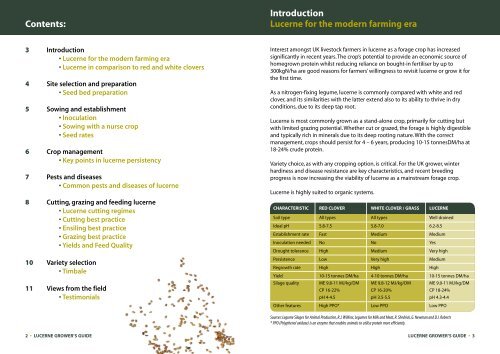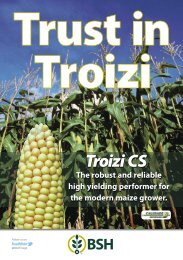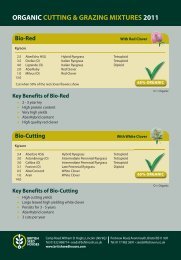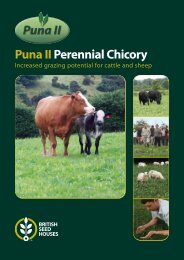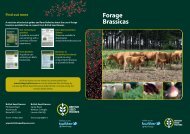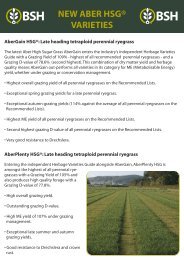Lucerne Growers Guide - British Seed Houses
Lucerne Growers Guide - British Seed Houses
Lucerne Growers Guide - British Seed Houses
- No tags were found...
Create successful ePaper yourself
Turn your PDF publications into a flip-book with our unique Google optimized e-Paper software.
Contents:Introduction<strong>Lucerne</strong> for the modern farming era3 Introduction• <strong>Lucerne</strong> for the modern farming era• <strong>Lucerne</strong> in comparison to red and white clovers4 Site selection and preparation• <strong>Seed</strong> bed preparation5 Sowing and establishment• Inoculation• Sowing with a nurse crop• <strong>Seed</strong> rates6 Crop management• Key points in lucerne persistency7 Pests and diseases• Common pests and diseases of lucerne8 Cutting, grazing and feeding lucerne• <strong>Lucerne</strong> cutting regimes• Cutting best practice• Ensiling best practice• Grazing best practice• Yields and Feed Quality10 Variety selection• Timbale11 Views from the field• TestimonialsInterest amongst UK livestock farmers in lucerne as a forage crop has increasedsignificantly in recent years. The crop’s potential to provide an economic source ofhomegrown protein whilst reducing reliance on bought-in fertiliser by up to300kgN/ha are good reasons for farmers’ willingness to revisit lucerne or grow it forthe first time.As a nitrogen-fixing legume, lucerne is commonly compared with white and redclover, and its similarities with the latter extend also to its ability to thrive in dryconditions, due to its deep tap root.<strong>Lucerne</strong> is most commonly grown as a stand-alone crop, primarily for cutting butwith limited grazing potential. Whether cut or grazed, the forage is highly digestibleand typically rich in minerals due to its deep rooting nature. With the correctmanagement, crops should persist for 4 – 6 years, producing 10-15 tonnesDM/ha at18-24% crude protein.Variety choice, as with any cropping option, is critical. For the UK grower, winterhardiness and disease resistance are key characteristics, and recent breedingprogress is now increasing the viability of lucerne as a mainstream forage crop.<strong>Lucerne</strong> is highly suited to organic systems.CHARACTERISTIC RED CLOVER WHITE CLOVER / GRASS LUCERNESoil type All types All types Well drainedIdeal pH 5.8-7.5 5.8-7.0 6.2-8.5Establishment rate Fast Medium MediumInoculation needed No No YesDrought tolerance High Medium Very highPersistence Low Very high MediumRegrowth rate High High HighYield 10-15 tonnes DM/ha 4-10 tonnes DM/ha 10-15 tonnes DM/haSilage quality ME 9.8-11 MJ/kg/DM ME 9.8-12 MJ/kg/DM ME 9.0-11 MJ/kg/DMCP 16-22% CP 16-20% CP 18-24%pH 4-4.5 pH 3.5-5.5 pH 4.3-4.4Other features High PPO* Low PPO Low PPOSources: Legume Silages for Animal Production, R.J. Wilkins; Legumes for Milk and Meat, R. Shedrick, G. Newman and D.J. Roberts* PPO (Polyphenol oxidase) is an enzyme that enables animals to utilise protein more efficiently.2 • LUCERNE GROWER’S GUIDELUCERNE GROWER’S GUIDE • 3


